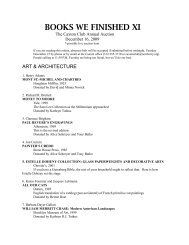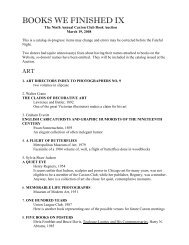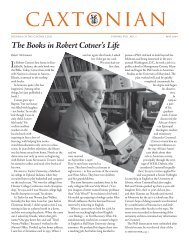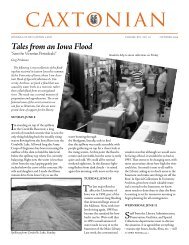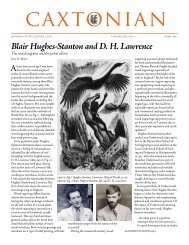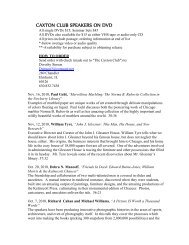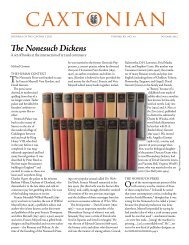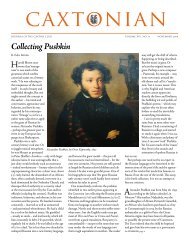Easter Egg Chickens - The Caxton Club
Easter Egg Chickens - The Caxton Club
Easter Egg Chickens - The Caxton Club
Create successful ePaper yourself
Turn your PDF publications into a flip-book with our unique Google optimized e-Paper software.
oC A X T O N I A N<br />
<strong>Caxton</strong> <strong>Club</strong>, Founded 1895<br />
Bruce H. Boyer, President<br />
Thomas E. Swanstrom, Vice-President<br />
Jo Ellen Dickie, Secretary<br />
Don Chatham, Treasurer<br />
David S. Mann, Past President<br />
Council<br />
Class of 2012<br />
Susan Hanes<br />
Robert McCamant<br />
Margaret Oellrich<br />
Morrell McKenzie Shoemaker, Jr.<br />
Mary S. Kohnke<br />
Class of 2013<br />
Matthew Doherty<br />
Tom Joyce<br />
Nancy Lynn<br />
Lynn Martin<br />
Jackie Vossler<br />
Class of 2014<br />
Michael Gorman<br />
Celia Hilliard<br />
Wendy Husser<br />
Hal Kugeler<br />
Dorothy Sinson<br />
Appointed Officers<br />
Jill Gage, Programs<br />
Paul F. Gehl, Archivist-Historian<br />
Hayward R. Blake, FABS<br />
Representative<br />
Committees<br />
Tom Joyce, Dorothy Sinson (Co-<br />
Chairs), Audio Visual<br />
J. William Locke, Dorothy Sinson<br />
(Co-Chairs), Friday Luncheons<br />
Dan “Skip” Landt, Margaret<br />
Oellrich, Membership<br />
Susan Rossen, Kim Coventry,<br />
Publications and Exhibitions<br />
Martha Chiplis, Scholarship<br />
Charles Spohrer, John M. Dunlevy,<br />
Matthew Doherty, Web Site and<br />
Directory<br />
<strong>Caxton</strong> <strong>Club</strong> Staff<br />
Dan Crawford, General Manager<br />
<strong>Caxton</strong>ian<br />
Robert McCamant, Editor<br />
Brenda Rossini, Copy Editor<br />
Robert Cotner, Founder<br />
Matthew J.Doherty, Wendy Husser,<br />
Paul Ruxin, Florence Shay,<br />
Contributing Editors<br />
©2012, <strong>Caxton</strong> <strong>Club</strong>. <strong>The</strong> <strong>Caxton</strong>ian is published<br />
monthly by the <strong>Caxton</strong> <strong>Club</strong>, whose office is<br />
in the Newberry Library. Printing: Envision<br />
Graphics, LLC, Bloomingdale, IL.<br />
EASTER EGG CHICKENS, from page 1<br />
politicians, bankers, and industrialists, who sat on<br />
the National Geographic’s Board of Trustees, were<br />
surely there as well. A large cocktail buffet offered<br />
huge bowls of crabmeat spread. Crab was a luxury<br />
we did not encounter much as poor students, and<br />
here was the opportunity to gorge on unlimited<br />
quantities. While Rebecca scanned the room for<br />
VIPs, I fed at the trough. But after the first few<br />
mouthfuls, I bit on something hard and irritating.<br />
<strong>The</strong>re was a piece of shell in the crabmeat.<br />
For my tenth birthday, my Aunt Shirley, a wise<br />
and cultured woman, gave me a subscription<br />
to the National Geographic. No, that’s not quite<br />
right. What she gave me was a membership in<br />
the National Geographic Society, which was the<br />
only way you could get a subscription to the magazine.<br />
One of the magazine’s attractions was that<br />
it represented an achievement of sorts. You didn’t<br />
just receive a publication every month. You were a<br />
member of an enormous organization led by very<br />
important people. <strong>The</strong> magazine was always telling<br />
its readers what “your Society” was doing, even<br />
though the subscribers – excuse me, the members<br />
– had no actual voice in deciding what the Society<br />
did or how it was governed. But there was a definite<br />
marketing power in the membership concept. When<br />
my aunt gave me the membership, I felt in some<br />
way that we had taken a step forward by becoming a<br />
National Geographic family.<br />
My first issue was January 1961. <strong>The</strong> cover story<br />
was a tour of the White House led by Mamie<br />
Eisenhower. You may remember that one of Jackie<br />
Kennedy’s best-loved moments as First Lady was<br />
her televised White House tour. But the National<br />
Geographic, perhaps to no one’s surprise, looked<br />
backward to the Eisenhowers on the eve of John<br />
Kennedy’s inauguration. I noted a moment ago<br />
that the Society was led by very important people.<br />
How did I know? <strong>The</strong> magazine’s masthead told<br />
me and at the same time explained why the Eisenhowers<br />
had received its favor. <strong>The</strong> Chairman of the<br />
National Geographic Society’s Board of Trustees<br />
was Gilbert H. Grosvenor, Melville’s father and<br />
Gilbert M.’s grandfather. Gilbert H. was a cousin<br />
of William Howard Taft and a friend of Teddy<br />
Roosevelt.<br />
Others on the board, with their credentials prominently<br />
listed, were Chief Justice Warren; Robert<br />
Anderson, Eisenhower’s secretary of the treasury;<br />
Robert Fleming, chairman of the Riggs National<br />
Bank; Crawford Greenewalt, president of DuPont;<br />
Curtis LeMay, the Air Force general who later ran<br />
for Vice President on George Wallace’s third-party<br />
ticket; Randolph Maddox, vice president of AT&T;<br />
Laurance Rockefeller, John D.’s grandson; and Juan<br />
Trippe, president of Pan American World Airways.<br />
Had his parents known he would eventually found<br />
an airline, would they have named him Juan Way<br />
Trippe?<br />
To be sure, there was nothing sinister in a tour of<br />
the White House led by the grandmotherly Mamie<br />
Eisenhower. But the National Geographic really did<br />
have a soft spot for entrenched regimes. Gilbert<br />
H. Grosvenor, the magazine’s editor from 1899 to<br />
1954, promulgated seven principles to guide the<br />
magazine’s content, one of which was “only what<br />
is of a kindly nature is printed about any country<br />
or people, everything unpleasant or unduly critical<br />
being avoided.”1<br />
Grosvenor’s policy led to some editorial decisions<br />
that, in hindsight, seem remarkably bad. For<br />
example, in February 1937, the magazine published<br />
an article titled “Changing Berlin,” which, among<br />
many observations praising the Nazi government’s<br />
achievements, kindly and pleasantly observed:<br />
As a substitute for Scout training, German youngsters<br />
now join an institution known as the Hitler<br />
Youth organization. Its emblem is the swastika, and<br />
its wide activities and political training are enormously<br />
popular with all classes.2<br />
As if to underline that sentiment, the article was<br />
illustrated with several full-page color photos of<br />
swastika banners hanging from public buildings.<br />
Fascist Italy received similar treatment the next<br />
month in an article titled “Imperial Rome Reborn.”<br />
<strong>The</strong> author’s opening was both kindly and pleasant:<br />
I stood under Benito Mussolini’s office window after<br />
Addis Ababa fell. I saw him throw up his strong<br />
right arm and say, slowly and distinctly: “<strong>The</strong> war is<br />
finished!”<br />
<strong>The</strong> Roman Empire was reborn that night. Later it<br />
was named, “L’Imperio Italiano,” yet Romans rule<br />
it as surely as their fathers from the near-by Forum<br />
ruled most of the world they knew.<br />
Empires have fallen. This one – and this one alone<br />
– has risen again.3<br />
By 1961, the year I became a member, things had<br />
changed a little, but not much. <strong>The</strong> August issue was<br />
my introduction to Laos, described as “a quiet land<br />
of rice farmers” placed in danger not so much by<br />
the gathering political storm as by “the 20th century”<br />
itself.4 <strong>The</strong> author quotes “a thoughtful American”<br />
as saying that the average Laotian life expectancy<br />
was only 35 years, adding: “But who can say that in<br />
a way he hasn’t lived longer than the average American,<br />
never having felt the pressure of time?”5 Kindly<br />
indeed!<br />
1961 also produced an article titled “South Viet<br />
Nam Fights the Red Tide,” in which a Vietnamese<br />
man expressed the hope that the American forces,<br />
then only “advisors,” would some day be permitted<br />
<strong>The</strong> <strong>Caxton</strong> <strong>Club</strong> • 60 W. Walton St., Chicago, IL 60610-3305 • ph 312-255-3710 • caxtonclub@newberry.org • www.caxtonclub.org



